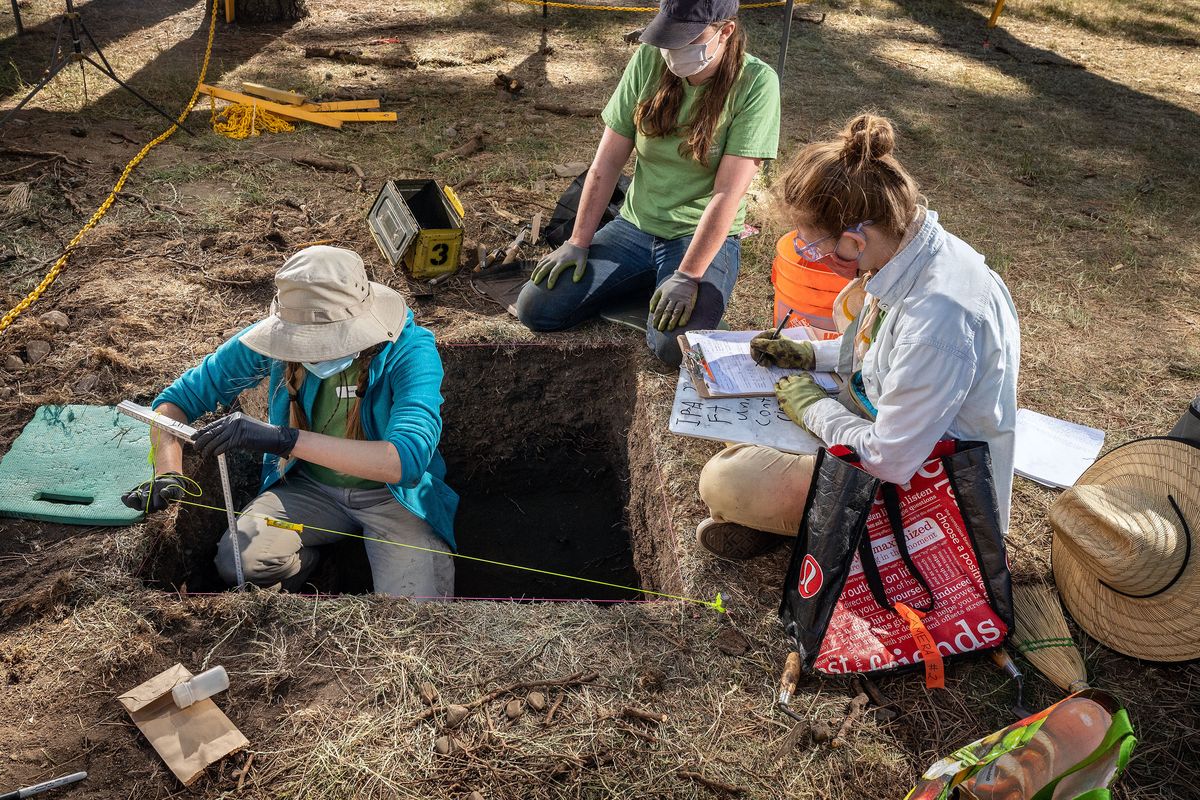Archaeological dig at North Idaho College aims to unearth ‘invisible histories’ of Fort Sherman

There was a point Monday when student archaeologists unearthed what looked like a shattered piece of wood from a hole several feet deep on the North Idaho College campus in Coeur d’Alene.
The find occurred at the tail end of a two-week historical excavation at sites that were once part of Fort Sherman, a U.S. Army stronghold established in the late 1800s. As part of an archaeology field school through the University of Idaho, the dig – organized through a collaboration between UI, North Idaho College and the Coeur d’Alene Tribe – involved students from five colleges and universities.
“Fort Sherman is an ideal location to explore identity construction and negotiation in spaces of cultural meeting,” said Katrina Eichner, an assistant professor of anthropology at UI. “It’s our hope that materials discovered here will allow for more diverse and nuanced understanding of the past.”
With the excavation complete, UI researchers will work to identify just what was found at the sites, which were set up along College Drive and West River Avenue approximately a half-mile apart. The northern site was once home to the fort’s married men’s quarters, said UI graduate student Conner Weygint. The noncommissioned officers’ quarters, meanwhile, were to the south.
By itself, the wood found at the northern site might be unspectacular from a historical archaeologist’s perspective, said Mark Warner, a professor of anthropology at UI.
It also might be irrelevant. Weygint said researchers believe the wood may have come from a sawmill located in that area after the fort closed.
That could change when evaluated alongside other finds from the digs, including bottle fragments, ceramic shards and other bits of fort life.
“One artifact doesn’t tell a story,” Warner said. “One hundred artifacts do.”
With Eichner helming the overall project, UI and North Idaho College researchers worked closely with the Coeur d’Alene Tribe on the endeavor given the land’s tribal history.
“The history of the fort is complicated and traumatic for Coeur d’Alene members,” Jennifer Fletcher, public relations director for the Coeur d’Alene Tribe, said in a statement. “The American military used the fort as part of a colonial campaign to remove the tribe from their ancestral homelands.”
Fletcher could not be reached for additional comment.
The fort was originally established in 1878 on a tribal land known as Hnch’mqinkwe’ used by Coeur d’Alene Indians, according to Spokane Historical. A year prior, Civil War Gen. William T. Sherman, who reportedly found the setting beautiful, recommended the site as a fort to the federal war department.
Camp Coeur d’Alene was officially established April 16, 1878. The name was changed to Fort Sherman in 1887, and the fort remained until it was abandoned just after the Spanish-American War around 1900, according to Spokane Historical.
A particular goal of the archaeological project is to highlight the history of the land’s native community in conjunction with contributions of women, children and Black soldiers occupying the fort.
“Stories of occupation in the West tend to focus on the roles of elite, white male military officers in hostile conflicts with Native American tribes,” Eichner said in a statement. “By focusing on this singular narrative, the stories and perspectives of a variety of historically marginalized groups are obscured in traditional heritage interpretations.”
Known as the 24th infantry, the unit of Black soldiers occupied the fort for approximately three years before Fort Sherman was abandoned, Weygint said.
“I think if you looked around and told people around Coeur d’Alene that they were here, you’d get a lot of surprised looks and people not knowing that the Army was here and an African American unit was here,” he said.
To help tell that story and other histories from Fort Sherman, project leaders enlisted students from UI, North Idaho College, Sweet Briar College, Augustana University and the University of California, Berkeley.
Warner said UI has previously hosted similar projects as a way of connecting with the community. Over the two-week period at North Idaho College, project organizers scheduled viewing periods for people to observe the archaeologists at work.
With the field school, students not only learned the history of what they were digging up, but also proper archaeological practices, said graduate student Katie Kitch.
“The bigger picture about historical archaeology, which is what this project is about, is sort of telling the histories of folks of the past in ways that people don’t think about,” Warner said. “There’s lots of recorded narratives and written records about life at the fort and so on. What the archaeology tells you is sort of the invisible histories that people don’t necessarily think about when trying to record the past.”